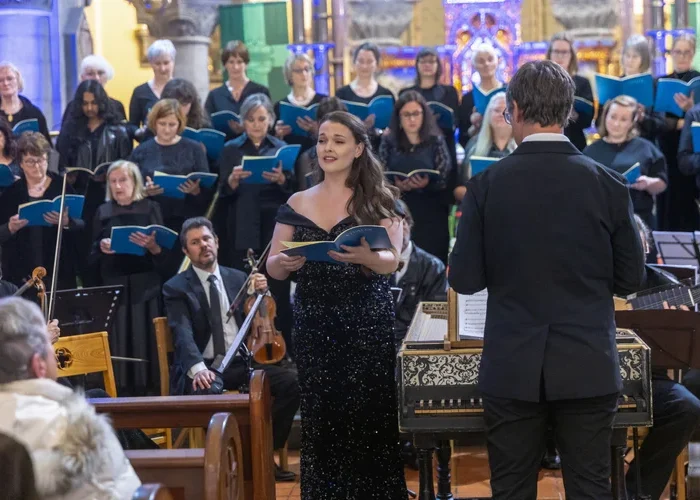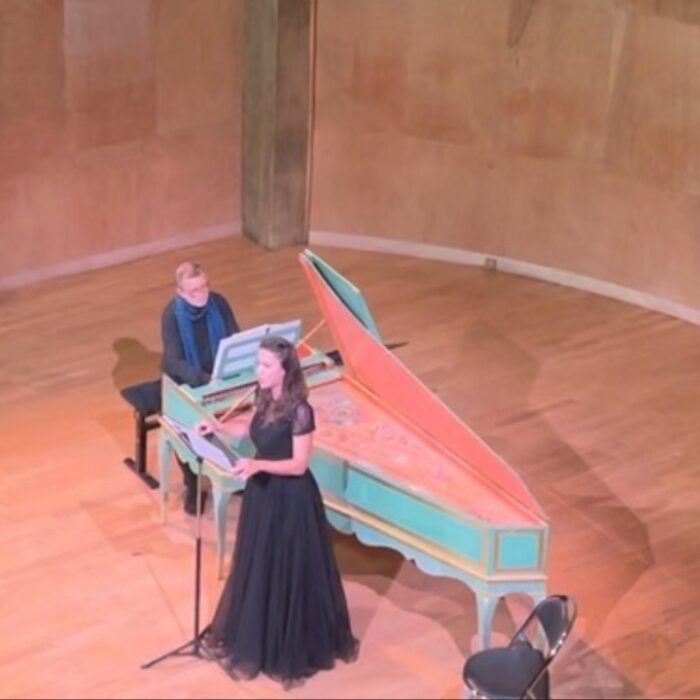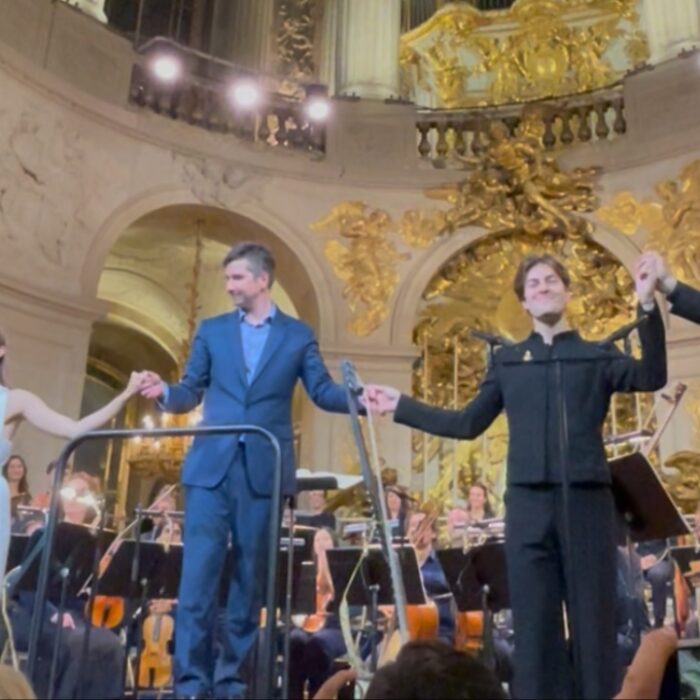
Princeton Festival 2025 Review: Tosca
Toni Marie Palmertree Stands Out In This Faithful Reproduction
By Chris RuelThis review of “Tosca” covers the June 17, 2025 production.
On a warm June evening, the Princeton Festival staged “Tosca.” The setting didn’t match the material. A breezy night under a white tent, sipping wine, is incongruent with heinous assault, torture, and suicide. But maybe that’s the point. “Tosca” doesn’t need help being dramatic. And once the drama starts, it doesn’t slow down.
Puccini doesn’t just flirt with operatic tragedy; it’s his calling card. The score is what you’d expect from Puccini: lyrical, strong in melody, and memorable. The drama is extravagant, over the top. But underneath the swells and silences is something colder. Uncomfortable. Rotten. Evil.
“Tosca” doesn’t build to catharsis, it builds to anti-catharsis. It lines everything up: the villain dies, the lovers reunite, there’s a deal on the table. But it all collapses. Scarpia’s stabbed. Cavaradossi shot. Tosca jumps. And nothing’s fixed. That’s the dark joke. If there’s justice, it’s theatrical. If there’s release, it lasts about five seconds. The rot stays, Spoletto the inheritor. That’s what makes the opera unsettling. It just keeps going until everyone’s dead.
Beneath it all, “Tosca” is a story about leverage. The love story dresses up the decay, but never conceals it. Power wears the mask of love and evil in equal measure. Everything collapses. No one is safe, not even those pulling the strings. This isn’t a slow burn. It’s a lit fuse wrapped around a powder keg.
The Princeton Festival’s production used a traditional staging, a scaled-down version of the Met’s classic Zeffirelli set. Scenic director Ryan McGettigan delivered a flawless reproduction. At the helm was Eve Summer who gave the audience a faithful rendition. Staid? Hardly. She kept the flow moving, actions had purpose, there was no updating or repositioning to fit today’s world. To remove “Tosca” from its historical setting would strip it of its power. The opera is a warped travel guide to Rome’s past, yes, but also an uncanny prophecy of the future. Rome’s secret police and ICE and DHS are one in the same, just with different acronyms. The resemblance isn’t political. It’s structural.
Control
It begins with a prayer, a painting, and a fugitive. Angelotti’s panicked entrance sets the tone. Cavaradossi isn’t pulled in by passion or politics. He just makes a choice—fast, maybe foolish—and now he’s part of something bigger than he understands.
Cavaradossi’s entrance aria, ‘Recondita armonia,’ isn’t a love song; it’s a manifesto. Beauty in opposition to darkness. Black eyes versus blue. The sacred against the profane. This is a study in contrast, not connection.
Tenor Victor Starsky—powerful in voice, bold in sentiment, and brassy as hell—delivered his lines with undeniable energy and dramatic force. But was he singing as a man in love, or as a man in love with an idea of love? His portrayal was less about flesh-and-blood affection and more the rush of idealism. Starsky’s Cavaradossi didn’t seem to know the difference.
Tosca, however, did.
Idealism runs through Tosca, as well, but it’s focus is on the self. Consider her reaction to the painting. She doesn’t see herself in it, instead, she sees a rival. So she revises the image, directing Cavaradossi to make it more like her ideal self. And he does. He always does. This is Tosca. She gets her way.
In this way, Tosca’s jealousy isn’t playful, although it is played that way. It’s survival. She has to remain at the top of the billing, or risk slipping into irrelevance. Obscurity. It’s never spoken, but the subtext hums beneath every line. Tosca’s defending the only power she’s ever been allowed to hold. It is this—her mortality is on display. Someday, she will die. What will remain? Her myth, perhaps. But the painting—that will endure. And it must be her. Not some anonymous ideal. Her. If she cannot live forever, she can at least be rendered immortal, a murderess as a saint. Her art, though profane, will live on in sanctity.
Soprano Toni Marie Palmertree brought a powerful, resonant voice to the role, one worthy of both the literal stage and the opera star she portrayed. The vanity of her character rode the musical wave. She didn’t just sing Tosca; she was Tosca. Trite words, yes. But nevertheless, true. She was there to impress, and she did in voice, emotion, and action. She makes Tosca the icon, immortalized both in the painting and status as a singer. It’s a demonstration of control and power, power over Cavadarossi’s art and being. Her use of parlando during heightened emotion added a good punch.
Scarpia’s entrance is classic bad guy, with music to match the archetype. His manner is darkly refined. He’s rot polished in fancy clothes. You almost miss how dangerous he is. Almost.
He isn’t there to rage. He’s there to work. And work, for him, is control. Torture isn’t a thrill; it’s procedure. His kind doesn’t sweat. They sign papers while someone screams in the next room.
Baritone Luis Ledesma, though strong vocally, never quite reached the level of menace the role demands. His voice carried, but didn’t disturb. The strength of his voice was there; the threat of Scarpia was not.
In Ledesma, we witnessed anti-catharsis, not by design, but by absence. Without true villainy, his death in Act two inspired no internal cheering, no bitter satisfaction. Only inevitability. The kind you feel when watching an opera you already know by heart.
And that is the heart of the opera. Everyone wants control. Some have it, but only for a moment. Tosca’s tragedy isn’t that she loses love. It’s that, for one brief act, she believed control was hers. She bent Scarpia to her will, only to be betrayed by his lieutenant, Spoletto (Nicholas Nestorak), whom she falsely believed wasn’t a threat. Her grasp of control was ripped from her hands by someone, let’s face it, smarter than her.
Scarpia’s line, “You make me forget God,” doesn’t indict Tosca. It indicts him. His actions, onstage and off, suggest God was forgotten long before Tosca ever appeared on his radar.
Act one ends not in revelation but in contamination. The Magdalen stares down from the easel, still beautiful, still false (neither Tosca nor the Marchesa), still dangerous. A Jezebel, spiritually and physically.
Twisted Negotiation
It’s easy to say Act two is about violence; an attempted rape accompanied by screams of torture. But that’s too simple. What’s truly happening is twisted negotiation, a hell-borne transaction that topples people like dominoes, one horrific scene knocking into another, ratcheting up the tension, and pulling true horror into the opera.
Tosca is asked not just to surrender her body. Scarpia weaponizes her devotion, her celebrity, and her love. Everything she’s built becomes a lever to be pulled. He wants to shatter her belief that goodness offers protection, that virtue, loyalty, and sacrifice can hold power at bay. When she kills him, it’s not redemption she finds. It’s herself. And she knows it. That’s why she gives him the funeral rites of a saint. She wraps the curse she brought upon herself in ritual—or better said, performance. It’s stagecraft. It’s what she knows. There’s a hint of the opera being self-aware. The dagger is in the hands of an opera star played by an opera singer on a stage before an audience. It is only natural for Tosca to mimic art in life, and in death.
Palmertree’s ‘Vissi d’arte’ was beautifully sung, not like a concert piece, which it often does, but as something necessary. Tosca sang it to herself. There was sorrow, yes, but mostly self-pity—the kind that comes when you realize the world isn’t playing by your rules. Pride, fragile and exposed. This was the moment the myth of Tosca cracked. “Tosca’s” center is the mother of all arias if their narrative function serves as an internal view of the character’s mind. We see it. We think it’s beautiful, but it’s narcissism in a black gown.
If there was a stumble on Palmertree’s performance it is in the ritual. There was a sense of been there, done that. I wouldn’t call it imitation, but also not original enough to kick you in the gut.
Ledesma offered little for Palmertree to push against. His Scarpia didn’t effectively seduce or manipulate. Palmertree was left negotiating alone, the weight of the scene falling entirely on her shoulders. She bore it. But the exchange never ignited.
A strong Tosca demands an equally powerful and disturbingly vicious Scarpia. Unlike Palmertree, who inhabited the role, Ledesma played Scarpia. That’s simply not enough. Lighter characters wouldn’t necessarily suffer from that approach. Musetta has little depth, but Scarpia could be mined for centuries.
Meanwhile, Starsky screamed operatically. There’s room for interstitial cries of agony that can provoke unnerving discomfort in the audience. These, however, weren’t slipped in between notated screams.
Illusion and Collapse
Act three opens in quiet. A shepherd boy sings. The city sleeps. It’s a lull before the final unraveling.
The rooftop of Castel Sant’Angelo is barren, wind-whipped. Cavaradossi is brought in. He’s been beaten, humiliated, broken—but still singing. That’s opera for you. And I’m only half-joking.
Opera requires a suspension of disbelief so complete, it turns into belief. We know it’s a lie, and we buy it anyway. That’s part of the deal. But “Tosca” takes it further. It doesn’t just ask us to believe. It shows us how the lie works.
This becomes clearest in the scene before the execution. Tosca, elated from the murder of Scarpia and drunk on the idea of escape, walks Cavaradossi through what’s supposed to be a staged death. And here, something strange happens. She doesn’t just console him. She directs him. Where to fall, how to fall, when to move. It’s stagecraft—within stagecraft.
Palmertree’s Tosca becomes both diva and director. She’s performing for two audiences: one in the world of the opera, the other sitting under the festival tent. She doesn’t just want Cavaradossi to survive. She wants the performance to be perfect. Because if she can control the illusion, maybe she can control the outcome. But she can’t.
The real bullets come. The opera doesn’t bend. Cavaradossi dies. The lie fails. And the audience—both hers and ours—watches it happen.
Starsky sang ‘E lucevan le stelle’ with more pathos than anything prior. His character was no longer a man wrestling with ideals; he was a man killed by them.
Palmertree, in these final scenes, did what she’d done all night: she held the opera together. Her Tosca still believed she could outwit fate. That’s what made it tragic. Not naïveté, but arrogance. The same belief that drove her to kill Scarpia in Act two—the illusion of control, now propels her toward the edge.
The execution is real. The bullets hit. Cavaradossi dies like a man who expected to survive. That’s the heartbreak. The betrayal, yes, but also the absurdity. Tosca played the role too well. Life didn’t follow the script.
Her jump, when it comes, doesn’t feel operatic. It feels inevitable. Not because of destiny or moral collapse. Because she ran out of ways to spin the story. There’s no lover to sing to, no aria to soften the landing. Just a body falling, offstage.
The music ends. Everyone’s dead. And the audience claps like it’s a happy ending. Maybe because it is safe, beautiful violence, resolved by applause. That’s “Tosca.”
Cathartic? Not by a mile. Not one character learns a thing. The audience’s emotional release is suspended because reality doesn’t follow a narrative arc. The opera ends, but nothing resolves. Just one final lie: beautiful, orchestrated, and devastating.
Orchestral music, whether it accompanies film, or television, or opera, aids the audience in swallowing the lie, suspending truth for a few hours.
Teamwork
A Puccini opera wouldn’t be a Puccini opera if it didn’t have a lush score that the listener can get lost in. But his music can wither without a conductor who knows how to pull the emotion from the notes in front of them.
Maestro Rossen Milanov had that ability in spades, never faltering during the hours-long performance. The music was always fresh. That doesn’t just require a good conductor, but a talented orchestra working in concert—with no pun intended—with a single goal: crush it.
Milanov and The Princeton Symphony did just that. This was not a band cobbled together with musicians of unequal skill. They were polished, never smothered the singers. The audience got balanced musicianship, not a rivalry, between the stage and pit.
In an opera built on illusion, Milanov and his orchestra gave the audience something that felt unmistakably real.


